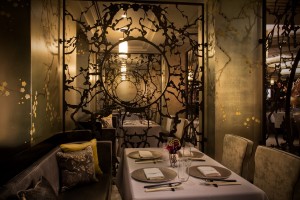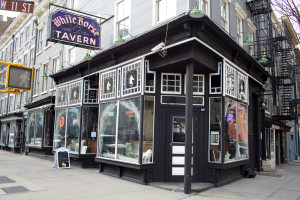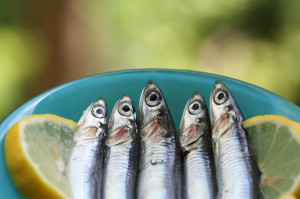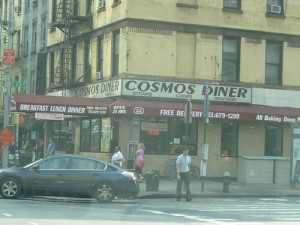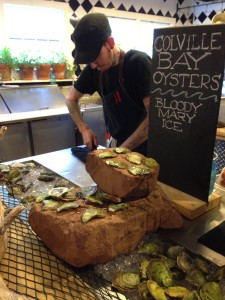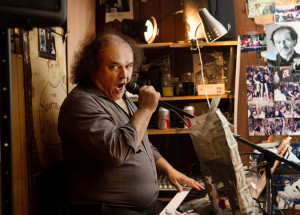Why do Jews love Chinese food? When HG lived in New York, HG noted a Sunday exodus of the city’s Jewish population to Chinatown. HG/BSK lived on the Upper West Side which had a very good, spacious restaurant, The Great Shanghai, plus the city’s first restaurant serving fiery Szechuan cuisine. HG/BSK only went to Chinatown to enjoy Sunday dim sum brunch. HG/BSK munched while reading the Sunday Times. SJ and little daughter Lesley were dedicated Chinese foodies from their earliest days. Dim sum was their favorite (This passion is still alive with them and their lovely children, all discerning consumers of soup dumplings). SJ has a theory about the history of Jewish love of Chinese food. SJ theorizes it all began when immigrant Jews from the Lower East Side would stroll to Chinatown to get a break from traditional Eastern European cooking. Their accents and struggles with English would not be embarrassing in restaurants whose staff had similar problems. Also, they could eat pork and shrimp, forbidden unkosher (“traif”) foods they would not cook at home. And, Chinese restaurants were very cheap. In these modern days of New York dining, a curious phenomenon exists. Affluent diners are willing to pay astronomical prices for esoteric Japanese food. But, they rebel against high prices at Chinese restaurants. This may be ending. La Chine restaurant in the Waldorf-Astoria Hotel is offering exquisite Chinese cuisine (plus some Japanese style Sashimi) prepared by famous chefs. The ingredients are superior and the prices are very expensive. Pete Wells, The New York Times restaurant reviewer, has given it a rave. HG/BSK will dine there when next in New York. Yes, it means a dent in credit cards. But, self indulgence is only a minor sin.
Chinese Dining In NYC
January 26th, 2016 § 0 comments § permalink
Hangouts
November 7th, 2015 § 0 comments § permalink
HG misses a certain type of codified New York City hangout for journalists, writers, poets and theater people. The species was exemplified by Elaine’s on Second Avenue where Woody Allen and scores of writers and performers received special treatment from the owner, Elaine Kaufman. The food was indifferent but HG enjoyed Elaine’s rough edged charm. Like HG, Elaine was a product of The Bronx and HG often greeted her with the soubriquet: “Elaine, the shapely Evander Childs alumna.” (Evander Childs being the name of a Bronx high school) She died in 2011 and the place was refurbished under new owners. Don’t believe it has recaptured the old ambiance. HG was lucky to spend some time with Elaine (some months before her death) at Le Veau d’ Or, the old time French bistro on E. 61st Street. HG had just finished lunching with SJ when Elaine came in. The two New York oldsters had some laughs and much cognac drinking. She, like her eatery, was an original. Pre-dating Elaine’s was Costello’s, a bar on Third Avenue and 44th Street. It opened when the El rumbled overhead and became a favorite with the staff of the New Yorker and their pals. Became a tourist attraction after James Thurber paid a Depression-era bar bill, by painting a 24 foot by 24 foot mural of his “War of the Sexes.” A.J.Leibling, Ernest Hemingway and John O’Hara drank there. According to legend, Hemingway broke his walking stick over O’Hara’s head. Details are sketchy. Like many good things in New York, Costello’s was demolished to make way for an office skyscraper. The mural disappeared. An art world mystery. Cedar Bar (never called Cedar Tavern) has disappeared from Greenwich Village’s University Place. It was the hangout of Motherwell, De Kooning, Pollock, Kline, Rothko and other distinguished artists (they were just gaining renown in the 50’s and 60’s). They were a hard drinking crowd much prone to fisticuffs. Lee Krasner, Pollock’s widow and a wonderful painter in her own right, said of the habitués: “They treated women like cattle.” HG would take HG’s little daughter, Victoria ,there on Saturday afternoon outings. HG would drink martinis and Victoria, perched on the bar, would eat peanuts and smile at her adult admirers. Presumably, Victoria’s early exposure to restaurants and strong drink has spurred her and chef/husband, Marc Meyer, to own and run four highly regarded New York restaurants: Cookshop, Vic’s, Hundred Acres and Rosie’s. Another Village hangout of artists, writer and poets (namely Dylan Thomas), was the White Horse Tavern on Hudson Street. Became famous for the presence of Thomas and Delmore Schwartz. Legend has it that Thomas consumed 18 shots of whiskey before walking (or stumbling) to his death.Though strongly identified with Thomas, it was actor Charles Laughton who made it famous. He would give away White Horse beer mugs to friends and fans. White Horse is still operating. Not very literary or poetic, it’s favored by college students. Best of the Village hangouts catering to journalists and writers, was the Lion’s Head on Christopher Street. Pete Hamill, Jimmy Breslin, Joe Flaherty, Frank McCourt, Norman Mailer, Sidney Zion, Vic Ziegel, Dennis Duggan and many others hung there. (An aside: Duggan reported for the New York Times and Newsday and was a fount of New York lore. HG was disturbed by Duggan’s unhealthy lifestyle and lured him to a gym on E. 45th Street where HG was a regular. Dennis didn’t like the mandatory exercises or the spartan atmosphere. After ten minutes, he said: “Okay. I came to your lousy gym. Can I have a drink now?”) The Lion’s Head closed some years ago but there’s now a Lion’s Head on Amsterdam Avenue much frequented by Columbia students. When HG was a journalist in the early 1950’s, HG spent much time at Artists & Writers (always called Bleeck’s) on W. 41st street near the offices of the old New York Herald-Tribune. Served very good German food and the convivial Trib journalists loved playing “the match game.” Lucius Beebe, the society columnist and elegant dandy, played with three custom made golden matches nestled in a velvet case. A class act. All of this has been swept away by time. Still functioning is Sardi’s, the theater restaurant a few blocks north of Artists & Writers. The endearing Vincent Sardi is gone and the food has gone downhill. A shadow of its former self. Lindy’s, Stage Delicatessen, Carnegie Delicatessen in the West 50’s, is where you found comics, song writers, press agents, bookmakers, gamblers. Lindy’s and Stage are gone and the Carnegie flourishes, selling overstuffed pastrami sandwiches to tourists. Russian Tea Room on W. 57th Street is where the classical music and ballet communities gathered as well as famous actors, producers and directors. HG once saw Jackie Onassis and Mike Nichols enjoying the Wednesday special, Siberian Pelmenyi. (this was a type of small ravioli served in strong chicken broth reinforced with mustard and sour cream). RTR is now an overpriced, over fancy place that has lost its luster. The hip Russian Tea Room crowd shifted to the Cafe Edison, a down to earth eatery in the Hotel Edison. The cooking was down home New York Jewish and the customers called the Cafe “The Polish Tea Room.” Alas, it closed this year, another victim of the real estate steamroller. HG imagines that the new generations of writers and painters and actors have their own places to drink and revel in the New New York, but HG doesn’t know them and can only hope they have as much fun in them as HG had in his own time.
The Anchovy
November 1st, 2015 § 0 comments § permalink
Recently, HG ordered Caesar Salad at a Santa Fe restaurant. The waiter asked: “Would you like it without anchovies?” HG was dismayed. After all, a Caesar Salad is unthinkable without the delicious salty addition of anchovies. But, the waiter was only doing his duty. There are many people who detest the salty oiliness of anchovies. HG loves anchovies, both unadorned and as a flavor enhancer of many foods. HG thought about the magical anchovy as HG enjoyed BSK’s sublime version of penne with broccoli. Here’s how BSK does it. First, BSK cuts short lengths of the broccoli stems. Not the very tough ends but the green, slimmer portion of the stems. They go into a food processor with shallots, parsley and garlic. This miix is then gently cooked in a sauce pan with olive oil and a goodly amount of chopped anchovy. The savory sofrito is thinned with pasta water after the penne is barely al dente and completes its cooking in the pan with slightly firm broccoli florets The dish is topped with chopped ripe tomatoes and mozzarella cheese (heated for a minute or two until the cheese softens). A sprinkle of red pepper flakes. The anchovies don’t give the dish a fishy overtone.Instead, they sharpen all the other flavors. Anchovies perform this function in many other dishes. (HG is very fond of pizza topped with anchovies). The French often lard a leg of lamb (gigot) with anchovies. Haven’t tried it but HG gathers the anchovies bring flavor to the lamb without overwhelming it and create the basis for a tasty sauce. One of HG’s favorite appetizers is anchovies with roasted red peppers as prepared in New York’s old time Italian restaurants. The peppers were roasted over an open flame until the skins were blackened. Popped in a paper bag for a few moments (the steaming in the bag makes it easier to remove the skins). Marinated for a bit with olive oil and a dash of vinegar. Served with a topping of anchovies. Best version was served by a long gone Italian restaurant on E. Houston Street (Lombardi’s?).They also served Mozarella en Carozza (breaded and fried cubes of mozzarella) with an anchovy sauce and Bagna Cauda (a warm dip of olive oil, butter, anchovies and garlic in which you dipped raw vegetables). Anchovy shopping advice from HG. There are heavily salted anchovies sold from barrels in a few older New York Italian grocers in Manhattan and Brooklyn. They have to be soaked in many changes of water to make them edible. Not worth it. Instead, buy jarred Italian anchovies. Don’t buy tinned anchovies. HG has enjoyed “Alici” in Italy. These are fresh, uncured anchovies with a mild taste. “Boquerones,” pale, unsalted anchovies pickled in vinegar are a staple at Spanish tapas bars. Dried anchovies are often used as a flavor base in many Japanese stocks — including Ramen. HG’s very beautiful granddaughter, Arianna R., was an elementary school student in Venice. School lunches are a serious matter in Italy. Her teacher deplored Arianna’s small appetite and said her minimal eating would make her look like an “acciughe” (anchovy). Today, the young woman has a robust appetite but retains a slim silhouette. Must be metabolism.
Chinatown, My Chinatown
October 19th, 2015 § 0 comments § permalink
The explosive growth of the Chinese population of New York has led to the creation of a number of new “Chinatowns” scattered throughout the five boroughs. The Flushing neighborhood of Queens is much larger than Manhattan’s Chinatown and far outclasses it in terms of quality and variety of cuisine. (Along Northern Boulevard and in the surrounding community of Murray Hill, there are also many good Korean restaurants and supermarkets). SJ is a Flushing expert and has led HG and BSK to some extraordinary eating adventures. There are also growing Chinatowns in Brooklyn. Sunset Park is the largest. But, for nostalgic HG there is only one true Chinatown: Manhattan’s Chinatown. HG has been dining in that Chinatown for 76 years. It all began when 10-year-old HG and his late beloved sister, Beulah Naomi, would board the Third Avenue El at the Fordham Road station in The Bronx. The leisurely train voyage had its delights. We would peer into tenement windows along the route (saw some remarkable family scenes). A highlight was the huge shiny brass brewing vats of the Jacob Ruppert Beer Company in the East 90’s neighborhood. (A sidebar: Ruppert, which went out of business in 1965, was once America’s best selling beer and Jacob Ruppert, son of the founder, was the owner of the New York Yankees baseball club. He brought Babe Ruth to New York, a move which led to decades of baseball supremacy.) HG and his sister descended from the El at Chatham Square. Chinatown was quite small in these days (bounded by the Bowery and Canal Street with Mott, Pell, Bayard, Elizabeth and Doyers as its principal streets. It was many years later that Chinatown metastasized, taking over much of Little Italy and the Lower East Side.) The street scenes of Chinatown delighted little HG (they still do). The strange and often inscrutable foods spilling onto the sidewalks. The exotic, musical language. The appearance of the neighborhood inhabitants (Years ago, many older Chinese men still sported pigtails). Luncheon choices for HG and sister were conservative. Won ton soup. Egg rolls. Barbecued spare ribs. Chicken chop suey (or chow mein). Rice. Tea. Almond cookies. It was a feast. The cost (for two) was 65 cents (with tip). The El fare was 5 cents. A wonderful day of sightseeing and feasting for less than a dollar (for two happy people). HG’s Chinatown food tastes became more sophisticated through the years. Shrimp in lobster sauce, Moo Goo Gai Pan, stir fried beef and broccoli became favorites. Chinatown remained wonderfully cheap, the perfect venue for college dates. In the 1950’s, HG and pals would dine at Yuet Sun. Our table of six or eight would devour shrimp in black bean sauce, pork livers, fried dumplings, garlicky greens, stir fries of pork, beef and chicken; noodles, rice. On the table were many cans of icy beer purchased from an nearby grocer. The jolly meal cost about 2 dollars a person. Later, HG’s favorite restaurant was Bo-Bo’s on Pell Street.Esther Eng, an imperious lady of the theater and one of the first (and greatest) female directors of Chinese language films, ran Bo-Bo’s. Bo-Bo’s was one of Ms. Eng’s five restaurants and enormously influential in exposing the sophistication of Chinese cuisine to America — the lobster rolls and steak dishes were outstanding. HG took BSK to Bo-Bo’s on their first date in 1963. When living in New York and New Jersey, HG/BSK and children were weekly visitors to Chinatown. Oriental Garden for great squab and pepper-and-salt grilled shrimp. Hong Fat for fried crabs. Phoenix Garden for flounder in black bean sauce, HSF and Nom Wah for Sunday dim sum brunch. (For years, Nom Wah on Doyers Street was the only dim sum eatery in New York). There were other places on the Bowery and elsewhere (names forgotten) that specialized in fried chicken, snails, clams in black bean sauce, etc. Chinatown changed and grew. Big Hong Kong-style dim sum palaces. Bubble tea store fronts. Congee made an appearance. Shanghai soup dumplings became a craze. HG still likes Chinatown food. Sad news is that Full House on Bowery near Hester has morphed into Flaming Kitchen. This super-modern, hi-tech space prepared superb Cantonese fish dishes and now caters to the hip, new style of Szechuan heat. However, Dim Sum Go Go is still dispensing good dim sum. Big Wong does superior congee and maintains the funky, old time Chinatown flavor. Nom Wah has been spruced up but retains its original vibe although foodwise HG/BSK had one good and one bad experience there. Bo Ky on Grand serves very good Vietnamese food. There’s good ethnic eating from a variety of Chinese regions on Eldridge, Chrystie, Allen, Forsyth and East Broadway. Yes, Flushing and Sunset Park have stolen some of Chinatown’s food luster but, HG remains loyal. And, it’s easier to get to than Flushing.
Controversial Okra
October 15th, 2015 § 2 comments § permalink
Okra. This rather strange vegetable (It traveled to America with the earliest slave ships), provokes strong emotions. Some love it. Some hate it. Count HG among the lovers of this rather slimy treat. In HG’s college days (at uptown CCNY), HG often supped at plain spoken Harlem eateries that served ribs, pork chops and fried catfish. They were not focused on “health” food. Three vegetables were offered: Onions (fried); Collard Greens (cooked with ham hocks); Okra (breaded and fried in sizzling lard). HG often ate pork chops smothered in caramelized onions and accompanied by delicious fried okra. The okra were doused with vinegar steeped with fiery Scotch Bonnet peppers. (Young HG’s appetite was honed by football practice at Lewisohn Stadium so HG filled out the meal with a big bowl of macaroni and cheese). HG’s love affair with okra continues. Texas pickled okra is great condiment. Okra is essential in a good gumbo. (SJ’s chicken gumbo, reigning king of all gumbos, contains mucho okra). HG is looking forwards to a favorite meal tonight. Fried pork chops dusted with Goya Adobo. Goya black beans topped with chopped sweet onions and a dab of sour cream. Sauteed peppers. And,of course, pan fried okra and onions (no breading) enhanced with plenty of Slap Yo Momma Louisiana Cajun spice. Anchor Steam Beer mixed with Guinness Stout will be the beverage.
Old Fogey Food Memories
September 22nd, 2015 § 0 comments § permalink
Mimi Sheraton, who is one of HG’s favorite food/restaurant writers (she was the NY Times restaurant critic for many years), once recalled the chow mein she ate in Brooklyn restaurants during her youth: “I still remember the mild soothing taste of that food, primarily the flavors of celery, bean sprouts and onions. It is far removed from the sophisticated (and truly better) Chinese food now fashionable, but there are moments when I would trade six of the best Szechuan meals in town for one plateful of that old chow mein (pronounced ‘sharmane’) nostalgia.”) The quote is from Sheraton’s book, From My Mother’s Kitchen. an indispensable guide to Jewish family cooking. Yes, HG shares her chow mein nostalgia. HG often enjoyed the terribly messy but strangely appealing chow mein sandwiches dispensed by the Nathan’s Famous hot dog emporiums in Coney Island and Manhattan’s Seventh Avenue. Years ago, HG and gourmand companion Charles E., would meet for a stealthy lunch in a dimly lit Sixth Avenue Chinese restaurant. They would devour “combo platters” of chow mein, fried rice and greasy egg rolls. Like illicit lovers, they would leave the restaurant swiftly and furtively to avoid being seen by friends with elevated dining tastes. Yes, nostalgia has a kick: A week or so ago, a ferocious north wind was battering Prince Edward Island. Outside, the windows of HG/BSK’s home revealed a sea topped with a froth of whitecaps. For some obscure reason, the tumultuous weather made HG remember the plain-spoken comfort food HG enjoyed decades ago in New York bar-and-grills, diners and coffee shops: Corned beef and cabbage with boiled potatoes on Third Avenue (when the El rumbled overhead). Open faced pot roast sandwiches drenched in rich brown gravy. Ditto open faced turkey and roast beef sandwiches (accompanied by mashed potatoes and cranberry sauce or insipid vegetables). liver and onions topped with bacon. Salami and eggs served “pancake style.” Spaghetti (never al dente, always overdone) with big meatballs and “red sauce.” A simple “bowl of red”–chili topped with raw onions and grated cheddar. BLT’s on whole wheat toast with loads of mayo. That night BSK and HG devised a PEI dinner that provided comfort: Grilled weissurst (veal) sausages with sweet mustard. Sauerkraut. Boiled local potatoes. Yellow bean salad. Gahan’s PEI ale. There was a fire in the Danish stove and sounds of Mozart. The winds did blow. The sea surged. And HG/BSK (and Toby, The Wonder Dog), were snug in their comfort zone.
Fire-Works Feasting
September 6th, 2015 § 2 comments § permalink
HG/BSK participated in a joyous, uninhibited, super abundant feast, a tribute to natural Prince Edward Island produce,meat and fish. The feast is FireWorks and it is served at the Inn at Bay Fortune, a beautiful inn overlooking a glistening bay. The meal is the brainchild of Michael Smith, a towering figure in Canadian cuisine.(Figuratively and literally. He’s six feet seven). Smith made his culinary reputation at the Inn some years ago before opening Maple, a Halifax, Nova Scotia restaurant, that had a two-year run (One of HG/BSK’s favorite dining places). His PEI restaurant and Maple were selected as among Canada’s ten best restaurants. Smith gave up his restaurant career to concentrate on writing cookbooks (He’s written eight with a ninth due this autumn) and launching a television career. His program on the Canadian Food Network and other channels soon made him Canada’s best known chef. Earlier this year, Michael and his wife, Chastity, returned to their PEI roots and purchased Inn at Bay Fortune. (the stunning building and grounds were once the summer home of actress Coleen Dewhurst). Michael expanded the Inn’s adjoining farm and herb gardens while building one of the most unusual kitchens in North America. The centerpiece is a 25-foot long brick wood burning grill. Everything at the Inn is cooked on or in “the fire monster.” It combines the functions of a smokehouse, open hearth, grill, oven, rotisserie and plancha (a metal plate). No dials. No switches. Just burning wood and a dedicated crew under the skilled leadership of chef Cobey Adams. Meals are served at two long tables facing Fortune Bay (each seating some 30 diners) and at tables in the Wine Library and “Fire Kitchen.” Here’s what HG/BSK ate at this rustic grand bouffe. The duo strolled among three outdoor stations: One offering cocktails made from locally distilled gins; another providing PEI Gahan’s beer and ale and one tempting folks with chunks of barbecued pork sausage enhanced by a savory beer mustard (HG, knowing that much awaited, ate only a few). Then inside to the “Fire Kitchen,” where glasses of Oyster Bay Sauvignon Blanc in hand, HG/BSK nibbled smoked salmon with lemon caper aioli on thin rye toasts while watching the cooks busily at work on “the fire monster.” Appetites properly honed, HG/BSK moved to an adjacent room. Delight awaited HG. All you can eat oysters. And, not any old oysters. Two expert young men busily shucked Johnny Flynn’s Colville Bay oysters. When in season (and these had just entered their glory) Colville Bays have distinctive green hued shells and are incomparable. Michael Smith thinks they are the best oysters in the world (HG/BSK agree). They combine brine with a faint sea sweetness and a firm, succulent texture. HG succumbed to mad oyster lust. HG ate some 40 oysters. (Hey, that’s not too greedy. Diamond Jim Brady would often preface his huge meals at Rector’s with four dozen oysters). The FireWorks shuckers dabbed some of the oysters with “Bloody Mary Ice”, but HG passed, not wishing to mar the pure oyster experience.With appetite barely sated by the bivalve overindulgence, HG sat down to some serious eating. (BSK was so busy taking photos that she only managed to score about six oysters). First course was “12 Grain Red Fife Sourdough Bread–Whipped Brown Butter.” This had such a tangy, grainy taste ,that HG could have knocked off an entire loaf with butter and red wine and gone home happy. But, HG behaved with restraint. Much more to come. “Taste of the Island Board” (Lonzino, Pork Rilette, Glagow Glen Fenugreek Gouda, raw carrots, tomatoes and green beans; arugula pesto, flax crackers). HG found this uneven. The pork rilette was very good. The lonzino would have been better with some of the beer mustard served outside. Some of PEI’s great mustard pickles would have enlivened the plate. HG gave the cheese only a nibble though it’s an HG/BSK favorite. (HG likes cheese at the end of a meal, not at the beginning). Next up (was “Chowder Kettle” (Island mussel broth, bar clams, Fortune Wharf she-lobster.)” The chef eliminated lobster (BSK’s allergic) from BSK’s serving. HG’s had plenty of juicy lobster and mussels in a lushly herbaceous chowder. The bowl was marred by a rubbery bar clam. (HG would have preferred quahogs in the chowder.). Next course was the high point of the meal, a dish which will long be recalled, with pleasure, by HG/BSK. This was “Hot Fish” (A duo of Blue Fin tuna–seared loin and tartare, black garlic aioli, sea rocket pesto, cabbage slaw, duck fat poached egg). This was tuna recently caught off HG/BSK’s north shore home (HG had watched a big blue fin tuna brought into Naufrage harbor and then eviscerated with expertise). The dish combined tender, meaty tuna with unusual sauces and textures. It worked beautifully. Next up was “Garden Salad” (Home grown salad containing 35 savory greens, tender leaves, herbs and flowers, apple cider and honey vinaigrette). HG, not usually a salad lover, gobbled this up joyfully. BSK, a salad fan, thought it was just so-so. The food climax was “Smoked Belly & Seawater Brined Loin” (Purple potato mash, seared zucchini, charred tomatoes, steamed beans & peas, smoked apple sauce, beet and ricotta salad.) The pork belly was a nice portion of pulled pork, some of it crisp and some moist and juicy. Some barbecue sauce would have been helpful. The loin was tender but tasteless. It needed a spicy chutney to give it life. The purple potato mash was sensational (even better than BSK’s great smashed spuds). The beans and peas were fine.The zucchini was watery and insipid. BSK liked the beet salad. Appetite running down, HG gave it a pass. Dessert was “Caramel Apple Shortcake” (Lemon basil and blueberry sorbet, Chantilly cream, plum cherries). A very refreshing climax. HG topped it off with one of the best coffees ever. HG/BSK drank Oyster Bay with the first courses and then a very good California Hahn Cabernet. Cost of the “FireWorks Feast” was $80 per person. Wine (HG/BSK drank six glasses) was $90 at $15 a glass. There was a lusty provincial tax. A 20% gratuity. All of these numbers are in Canadian dollars so with the strong US buck it cost HG/BSK about $200 US. It was well worth it. (Considering that HG/BSK ate oysters that would have cost about $150 in New York, the meal was an astounding bargain). The atmosphere, service, happy diners, pleasant conversation with Canadian table mates all contributed to a joyous evening. The food? Good. Not great (except for the tuna and the oysters). When it comes to locavore cooking , HG’s hero is chef Marc Meyer. Marc and HG’s daughter, Victoria, own and run four well regarded New York restaurants — Cookshop, Hundred Acres, Vic’s and Rosie’s. Marc has pioneered farm to table cooking. He is a master. Because of his rigorous sourcing of the best ingredients and precision cooking, even the simplest dishes become extraordinary. HG recalls watching two elegant Italian art dealers at Cookshop (at 10th Avenue and 20th Street it is in the heart of an art gallery district). They ordered chicken salad and a bottle of red wine. No, this wasn’t a mayonnaise and celery mess. It was chunks of crisp skinned free range chicken served on lightly dressed greens and dusted with herbs. In accented English, one of the men told the waiter how he wished something this simple and delicious could be found in Milan. Alec Lobrano, the premier critic of Paris restaurants (“Hungry For Paris”), dined at Cookshop and wrote that he wished Paris had a restaurant like Cookshop. HG is clear-eyed about food (if about little else). HG ‘s opinion of Marc’s cuisine is not skewed by family ties. HG calls them as he sees them.
Christ Cella – Never Forgotten
September 5th, 2015 § 7 comments § permalink
Christ Cella was a New York steak house on E. 44th Street. It opened in the 1930s and closed in the 1980s. Its glory years were the 50’s, 60’s and 70’s. Later, it was just a shadow of its former glorious self. On June 29, 2011, HG wrote about CC in a post entitled: “Gone But Not Forgotten Restaurants.” Well, CC certainly remains in the memory of many people. Not a week goes by without someone (including friends and relatives of staff who worked at the restaurant) contacting HG and sharing thoughts and memories of the restaurant. Older folks, veterans of Madison Avenue and the communications industry, recall happy three martini and steak lunches. The younger set remember joyous meals with their dads before sporting events. Even members of the Cella family have reached out to HG to recall the joy of the restaurant. HG ate there alone, with friends and when entertaining journalists HG wanted to influence. Every meal was a pleasure. The Christ Cella proprietors demanded the very best product. They and their customers were willing to pay (for the time) comparatively steep prices in order to get it. And, the kitchen crew treated the fine ingredients with respect and precision. When HG ordered a New York strip steak rare, HG received a steak that was charred on the outside and robustly red in the interior. Rare, not raw as is the fashion for steak in Paris. HG’s spring favorite of shad with shad roe and bacon was perfect, Never overcooked. The lemon butter sauce enriched the the fish and roe but never overwhelmed the fresh flavors. And, the bacon was crisp with nary a spot of grease. The boiled potatoes with parsley were just right. The Christ Cella emphasis on quality might be the reason it is remembered with such fondness.
Celestial Salmon
August 31st, 2015 § 0 comments § permalink
A few decades ago, HG/BSK and HG’s late sister and brother-in-law, Beulah and Daniel K., were seated in Le Vaudeville (Then very good. Now downhill.), the beautiful art deco brasserie opposite the Paris Bourse (stock exchange). Following some glorious appetizers (oysters for HG/BSK and Baltic pickled herring with warm potato salad for other duo), HG sipped chilled Muscadet and examined the carte. Saumon a l’ oseille was featured. This was grilled salmon with sorrel sauce, a dish made famous by chefs Pierre and Jean Troigrois at the brothers’ Michelin three-star restaurant in Roanne. Everyone at the HG table ordered it and it was a revelation. Salmon and sorrel were meant for each other. The slightly bitter and herbaceous sauce seemed the proper counterpoint for the rich (cooked semi rare) salmon filet. Sorrel is a rarity in American food markets. Here on Prince Edward Island, BSK cultivates a big crop of sorrel in the BSK herb garden. That means abundant sorrel soup and sorrel sauce. Salmon, of course, is the problem. Wild salmon has become ridiculously expensive and farm raised salmon is pumped full of artificial coloring, flaccid and tasteless. (HG/BSK are spoiled by their years in Vancouver where wild salmon is always available, inexpensive and delicious). The salmon HG/BSK purchase at By the Bay Fish Mart in St. Peters is farm raised in Nova Scotia in an apparently natural environment. Not as good as the wild but still tasty. HG/BSK grilled a big slab for dinner last night. BSK made sorrel sauce (sorrel, shallots, chicken broth, butter, egg yolks). Sublime. There were other good things on the table. Grilled asparagus. Fresh sweet corn (in season at last). Little potatoes dug from the Noel and Yossi M. garden earlier in the day. EM styled crisp fried pork bellies and mushroom caps smothered with chopped scallions and herbs. Another spectacular PEI dinner.
Music For Dining
July 15th, 2015 § 2 comments § permalink
During HG’s younger years in New York, there were many Hungarian (and Czech) restaurants on Lexington, Third and Second Avenues in the East 80’s and 90’s. The Czech restaurants specialized in tasty duck dishes. HG characterized the Hungarian eateries as “goulash by candlelight joints.” One of their common features was violin music provided by a “Gypsy” musician. The “Gypsy” would swoop down on individual tables and with many swooping gestures and soulful glances provide the diner with renditions of schmaltzy middle European cafe favorites. The object was to enhance the romantic mood of the diners. Somehow it worked (or maybe it was the copious amount of Egri Bikaver “Bull’s Blood” Hungarian red wine HG consumed). The “Gypsy” would continue to saw away until he was tipped. HG far preferred the “oompah, oompah” music provided by the band at Luchow’s, the glorious German restaurant on 14th Street. There were few jollier places in New York than Luchow’s during Christmas season when the venerable walls were adorned with holly and sparkling lights and the band focused on happy carols. Another pleasant winter music dining venue was the Edwardian Room of the Plaza Hotel. A cocktail pianist tinkled away in the background as diners ate in the handsome room gazing out at snow falling on Central Park. HG recalls a little steak house (name, alas, forgotten) where the owner, accompanied by a portable keyboard, sang show tunes to individual tables. His whiskey roughened voice was perfect for “Fugue for Tinhorns” from “Guys and Dolls.” And, then there’s Sammy’s Romanian on the Lower East Side. For many decades Sammy’s has featured music from singers, violinists and pianists singing old Yiddish music hall chestnuts and some popular melodies interspersed with low end, politically incorrect humor. The latest incarnation is Dani Luv, an Israeli born pianist with a killer Louis Armstrong impression. His audience, liberally stoked with vodka, garlic and chicken fat, is raucously appreciative.
